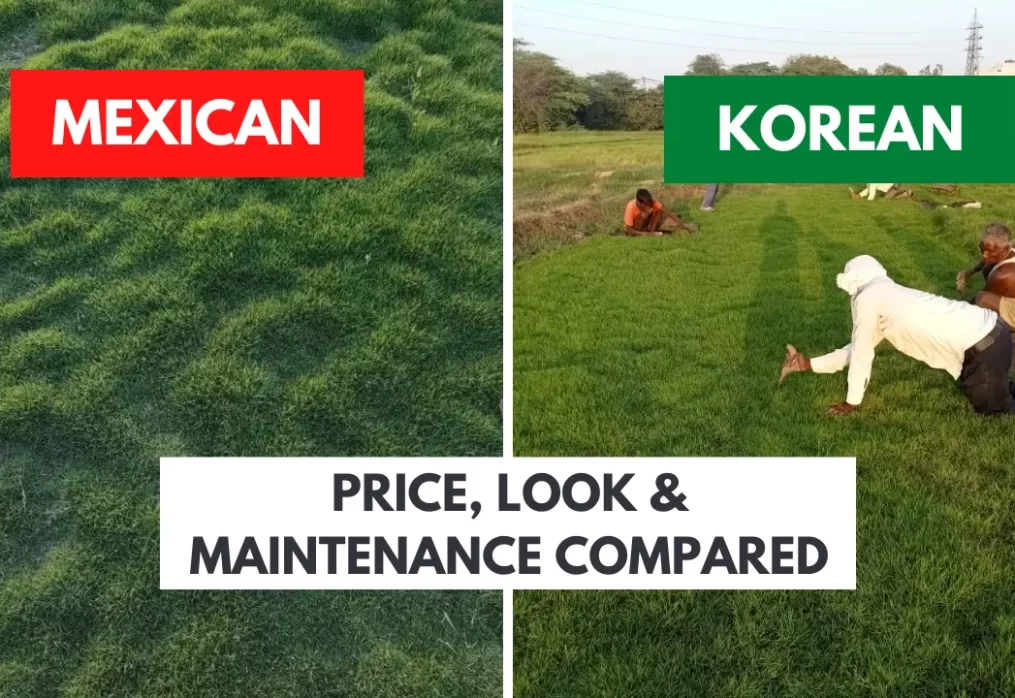Mexican Grass vs Korean Grass – Price, Look & Maintenance Compared
Introduction
Choosing the right lawn grass is a lot like picking the perfect outfit—you want something that looks good, fits your lifestyle, and doesn’t drain your pocket. Among the most debated options are Mexican grass and Korean grass. Both are widely used across India, but each comes with its own pros, cons, and price tag. Let’s dive in and see which one is the real winner for your lawn.
What is Mexican Grass?
Mexican grass, also known as Durva or Doob grass, is a hardy variety famous for its bright green color and dense coverage. It spreads quickly through runners, making it an excellent option if you want your lawn covered in no time.
- Origin: Native to tropical and subtropical regions.
- Best Suited For: Indian climates, especially where summers are harsh.
- Texture: Coarse and a bit spiky under bare feet.
What is Korean Grass?
Korean grass, also called Zoysia grass, is a premium lawn option admired for its fine blades and soft texture. Unlike Mexican grass, it grows slower but looks elegant once established.
- Origin: Southeast Asia, widely cultivated in India now.
- Best Suited For: Ornamental lawns and gardens.
- Texture: Soft, carpet-like feel, perfect for walking barefoot.
Price Comparison
One of the first things homeowners consider is cost.
- Mexican Grass Price in India: ₹5–₹10 per sq. ft. (affordable and widely available)
- Korean Grass Price in India: ₹15–₹30 per sq. ft. (premium range)
The difference is clear: Mexican grass is budget-friendly, while Korean grass is a luxury choice.
Look and Aesthetic Appeal
- Mexican Grass: Dark green, slightly rough, and gives a natural, wild look.
- Korean Grass: Soft, lush, and manicured—perfect for showpiece gardens.
If you want elegance and sophistication, Korean grass wins. If you prefer a natural, rugged lawn, Mexican grass is the way to go.
Growth Rate and Spread
- Mexican Grass: Fast grower. Covers bare patches quickly but may become invasive.
- Korean Grass: Slow grower. Takes time to establish but remains neat and compact.
Think of it this way—Mexican grass is like a fast-food joint (quick results, less polish), while Korean grass is like a fine-dining restaurant (slow, classy, long-lasting).
Maintenance Needs
- Watering:
- Mexican grass needs watering 2–3 times a week.
- Korean grass is drought-tolerant and needs less frequent watering.
- Fertilization:
- Mexican grass grows fast, so it needs fertilizers more often.
- Korean grass grows slowly, requiring fewer nutrients.
- Mowing:
- Mexican grass needs mowing every 7–10 days.
- Korean grass requires mowing once in 3–4 weeks.
Clearly, Korean grass is lower maintenance in the long run.
Durability and Usage
- Mexican Grass: Handles heavy foot traffic well. Perfect for play areas, sports grounds, and homes with kids and pets.
- Korean Grass: Not very durable under constant use. Best suited for decorative lawns where aesthetics matter more than durability.
Shade vs Sun Tolerance
- Mexican Grass: Can tolerate partial shade but thrives in full sun.
- Korean Grass: Loves sunlight and performs best in open lawns.
If your lawn has trees and shaded corners, Mexican grass adapts better.
Seasonal Performance
- Mexican Grass: Survives extreme summers but may turn brown in severe winters.
- Korean Grass: Stays greener in winter but slows growth in peak summer heat.
Installation and Establishment
- Mexican Grass: Available as sod rolls or by planting runners. Establishes quickly within weeks.
- Korean Grass: Sold as turf mats. Takes months to spread fully.
If you need a quick-fix lawn, go for Mexican grass. For a luxury, long-term lawn, Korean grass is worth the wait.
Pros and Cons of Mexican Grass
Pros:
- Affordable
- Quick coverage
- Strong and durable
Cons:
- Rough texture
- Needs frequent mowing
- Can spread uncontrollably
Pros and Cons of Korean Grass
Pros:
- Elegant and soft
- Low maintenance
- Premium look
Cons:
- Expensive
- Slow growth
- Not ideal for heavy use
Which Grass is Best for You?
- On a budget? Mexican grass is your best friend.
- Want a showpiece lawn? Korean grass will steal the spotlight.
- For kids, pets, or playgrounds? Mexican grass wins.
- For ornamental gardens? Korean grass takes the crown.
Conclusion
At the end of the day, the choice between Mexican grass and Korean grass depends on your priorities. If you want something quick, tough, and affordable—Mexican grass is the way to go. But if you’re dreaming of a lush, elegant, and low-maintenance lawn—Korean grass will give you that picture-perfect look.
FAQs
1. Which grass lasts longer—Mexican or Korean?
Korean grass lasts longer if maintained properly, while Mexican grass may thin out over time.
2. Is Korean grass really maintenance-free?
Not entirely, but it requires much less mowing and fertilization compared to Mexican grass.
3. Can Mexican grass survive in cold climates?
It struggles in very cold regions but usually bounces back in summer.
4. Which grass needs less water?
Korean grass is more drought-resistant, so it needs less water.
5. Which one is best for Delhi NCR homes?
Both work well, but Mexican grass is better for play areas, while Korean grass is ideal for luxury lawns
Last Updated on 3 months ago by Anjali Mehra Ph.D. in Horticulture (Punjab Agricultural University)
- Grass Types that Survive Frost & Snow (Uttarakhand-Specific) - December 6, 2025
- Low-Water Grass Varieties for Hilly Homes in Uttarakhand - December 1, 2025
- Mexican Grass vs Bermuda Grass – Which is Best for Indian Lawns? - November 28, 2025
